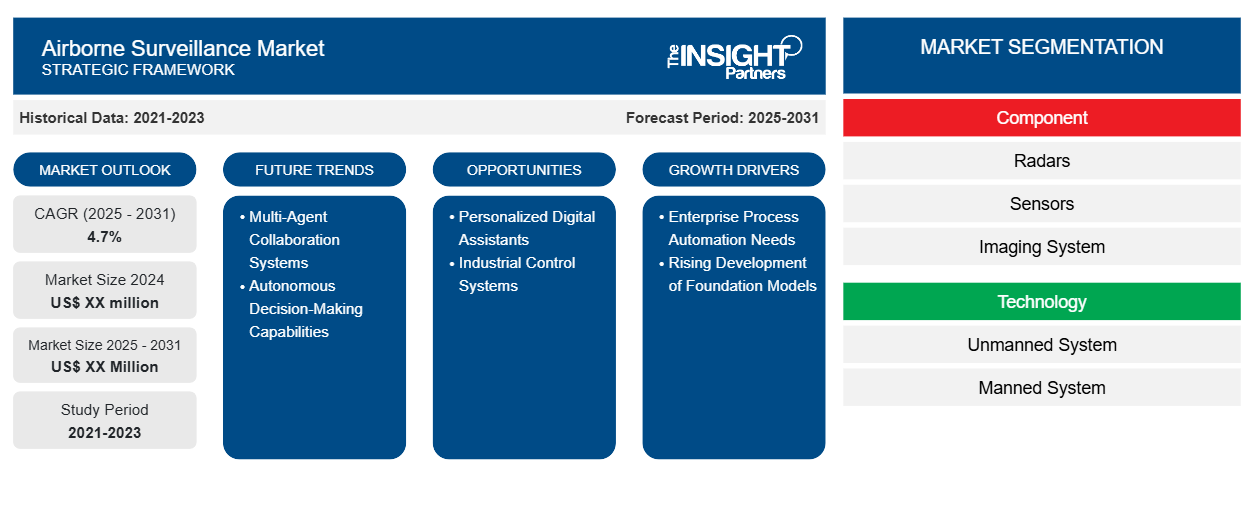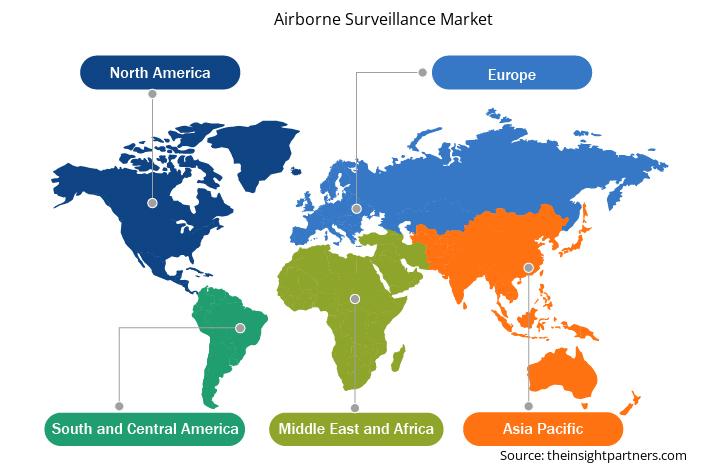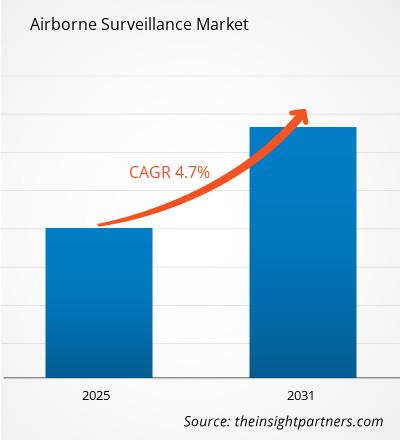空中監視市場は、2025年から2031年にかけて4.7%のCAGRで成長し、市場規模は2024年のXX百万米ドルから2031年にはXX百万米ドルに拡大すると予想されています。
本レポートは、コンポーネント(レーダー、センサー、画像システム、その他)、テクノロジー(無人システム、有人システム)、プラットフォーム(固定翼航空機、回転翼航空機、UAV)、アプリケーション(商業(農林業、検査・監視、エンジニアリング、測量・地図作成、その他)、軍事・政府(捜索救助、法執行、国境監視、ISRターゲティング))別にセグメント化されています。グローバル分析は、地域レベルおよび主要国別にさらに細分化されています。本レポートでは、上記の分析とセグメントについて、米ドル建てでの価値を提供しています。
報告書の目的
The Insight Partnersによる航空監視市場レポートは、現在の市場状況と将来の成長、主要な推進要因、課題、そして機会を解説することを目的としています。これにより、以下のような様々なビジネスステークホルダーに洞察を提供します。
- テクノロジープロバイダー/メーカー: 進化する市場の動向を理解し、潜在的な成長機会を把握することで、情報に基づいた戦略的意思決定を行うことができます。
- 投資家: 市場の成長率、市場の財務予測、バリュー チェーン全体に存在する機会に関する包括的な傾向分析を実施します。
- 規制機関: 市場の濫用を最小限に抑え、投資家の信用と信頼を維持し、市場の健全性と安定性を維持することを目的として、市場における政策と警察活動を規制します。
空中監視市場のセグメンテーション
成分
- レーダー
- センサー
- イメージングシステム
テクノロジー
- 無人システム
- 有人システム
プラットフォーム
- 固定翼航空機
- 回転翼航空機
- 無人航空機
応用
- コマーシャル
- 軍と政府
要件に合わせてレポートをカスタマイズ
このレポートの一部、国レベルの分析、Excelデータパックなど、あらゆるレポートを無料でカスタマイズできます。また、スタートアップや大学向けのお得なオファーや割引もご利用いただけます。
空中監視市場:戦略的洞察

- このレポートの主要な市場動向を入手してください。この無料サンプルには、市場動向から見積もりや予測に至るまでのデータ分析が含まれます。
空中監視市場の成長要因
- エンタープライズ・プロセス・オートメーションのニーズ:ビジネスオペレーションの複雑化と運用コスト削減の必要性から、企業はAIエージェントの活用を迫られています。組織は、定型業務、顧客対応、データ処理を人間の介入なしに処理できるソリューションを求めています。AIエージェントは24時間365日稼働し、人間よりも速く情報を処理し、運用を効率的に拡張できるため、ワークフローの合理化を目指す企業にとって特に魅力的です。このニーズは、顧客サービス、IT運用、管理業務などの分野で顕著であり、これらの分野では、一貫性と正確性を維持しながら反復的なプロセスを自動化できます。
- 基盤モデルの開発の進展:GPT-4、Claude、PaLMといった基盤モデルの急速な進歩とアクセス性の向上により、より洗練されたAIエージェントが実現しています。これらのモデルは、自然言語理解、推論、タスク実行といった基盤機能を提供し、AIエージェントを実世界のアプリケーションで実用的に活用できるようにします。基盤モデルの性能と計算効率が向上するにつれて、AIエージェント開発の参入障壁は低下し、潜在的なユースケースが拡大します。この技術基盤は、エージェントが文脈を理解し、意思決定を行い、人間と自然にインタラクトするために不可欠です。
航空監視市場の将来動向
- マルチエージェント・コラボレーション・システム:複数のAIエージェントが連携して複雑な問題を解決するシステムの開発が拡大しています。これらのシステムは人間のチーム構造を反映しており、複数のエージェントが特定のタスクに特化し、連携しながら作業を進めます。例えば、あるエージェントがデータ分析を担当し、別のエージェントがユーザーとのコミュニケーションを管理し、さらに別のエージェントがタスクの委任を監督するといった具合です。このアプローチは、多様な専門知識と連携を必要とする複雑なワークフローにおいて特に効果的であり、シングルエージェント・システムよりも堅牢で汎用性の高いソリューションを実現します。
- 自律的な意思決定能力:AIエージェントは、意思決定プロセスにおいてより高い自律性を持つように設計される傾向が強まっています。この傾向は、事前に定められたルールに従うだけでなく、経験から学習して戦略を適応させることができるエージェントの開発に特徴付けられます。これらのエージェントは、高度なリスク評価機能と、人間の介入なしに状況に応じた適切な意思決定を行う能力を備えています。この進化は、アルゴリズム取引、インフラ管理、サプライチェーン最適化などの分野で特に顕著です。
空中監視市場の機会
- パーソナライズされたデジタルアシスタント:個々のユーザーの好み、習慣、ニーズを深く理解し、高度にパーソナライズされたデジタルアシスタントとして機能するAIエージェントの開発には、大きな可能性があります。これらのエージェントは、個人のスケジュール管理、コミュニケーションのトリアージ、さらにはユーザーの行動パターンを包括的に理解した上でのレコメンデーション作成などが可能になります。このようなパーソナライズされたアシスタントの市場は、消費者向けアプリケーションにとどまらず、プロフェッショナル環境にも広がり、個人の生産性とワークライフバランスを大幅に向上させる可能性があります。
- 産業用制御システム:AIエージェントを産業用制御システムに統合することで、製造業やプロセス産業に大きなビジネスチャンスがもたらされます。これらのエージェントは、生産プロセスの最適化、メンテナンスの必要性予測、そしてリソース割り当てのリアルタイム管理を可能にします。複雑なセンサーデータを分析し、最適な状態を維持するための迅速な調整を行い、他のシステムと連携して効率的な運用を実現します。このビジネスチャンスは、産業界がインダストリー4.0やスマートマニュファクチャリングのパラダイムへと移行する中で、特に大きな価値を生み出します。
航空監視市場の地域別分析
Insight Partnersのアナリストは、予測期間を通じて航空監視市場に影響を与える地域的な動向と要因を詳細に解説しています。このセクションでは、北米、ヨーロッパ、アジア太平洋、中東・アフリカ、中南米における航空監視市場のセグメントと地域についても解説します。

- 航空監視市場の地域別データを入手
航空監視市場レポートの範囲
| レポート属性 | 詳細 |
|---|---|
| 2024年の市場規模 | XX百万米ドル |
| 2031年までの市場規模 | XX百万米ドル |
| 世界のCAGR(2025年~2031年) | 4.7% |
| 履歴データ | 2021-2023 |
| 予測期間 | 2025~2031年 |
| 対象セグメント | コンポーネント別
|
| 対象地域と国 | 北米
|
| 市場リーダーと主要企業の概要 |
|
空中監視市場のプレーヤー密度:ビジネスダイナミクスへの影響を理解する
空中監視市場は、消費者の嗜好の変化、技術の進歩、製品の利点に対する認知度の高まりといった要因によるエンドユーザーの需要増加に牽引され、急速に成長しています。需要の増加に伴い、企業は製品ラインナップの拡充、消費者ニーズへの対応のための革新、そして新たなトレンドの活用を進めており、これが市場の成長をさらに加速させています。
市場プレーヤー密度とは、特定の市場または業界内で事業を展開する企業または会社の分布を指します。これは、特定の市場空間における競合企業(市場プレーヤー)の数が、その市場規模または市場価値全体と比較してどれだけ多いかを示します。
航空監視市場で事業を展開している主要企業は次のとおりです。
- ロッキード・マーティン社
- L3ハリステクノロジーズ株式会社
- ノースロップ・グラマン・コーポレーション
- テレダインFLIR LLC
- ロイテックレーダーシステム
免責事項:上記の企業は、特定の順序でランク付けされているわけではありません。

- 空中監視市場のトップキープレーヤーの概要を入手
主なセールスポイント
- 包括的なカバレッジ:レポートでは、空中監視市場の製品、サービス、タイプ、エンドユーザーの分析を包括的にカバーし、全体的な展望を提供します。
- 専門家の分析:レポートは、業界の専門家とアナリストの深い理解に基づいて作成されています。
- 最新情報: このレポートは、最新の情報とデータの傾向を網羅しているため、ビジネスの関連性を保証します。
- カスタマイズ オプション: このレポートは、特定のクライアント要件に対応し、ビジネス戦略に適切に適合するようにカスタマイズできます。
したがって、空中監視市場に関する調査レポートは、業界の状況と成長見通しを解明し、理解するための先導役となるでしょう。いくつかの妥当な懸念事項はあるものの、このレポートの全体的なメリットはデメリットを上回る傾向にあります。
- 過去2年間の分析、基準年、CAGRによる予測(7年間)
- PEST分析とSWOT分析
- 市場規模価値/数量 - 世界、地域、国
- 業界と競争環境
- Excel データセット
最新レポート
お客様の声
購入理由
- 情報に基づいた意思決定
- 市場動向の理解
- 競合分析
- 顧客インサイト
- 市場予測
- リスク軽減
- 戦略計画
- 投資の正当性
- 新興市場の特定
- マーケティング戦略の強化
- 業務効率の向上
- 規制動向への対応




















 無料サンプルを入手 - 空中監視市場
無料サンプルを入手 - 空中監視市場